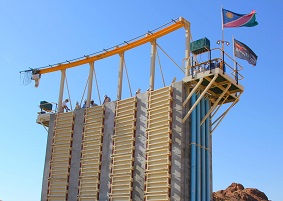
Construction continues to spearhead domestic economic growth
Domestic economic activities like construction are expected to drive economic growth for the entire 2014, the Bank of Namibia said this week when it released its latest forecasts titled Economic Outlook for 2014-2016.
The Economic Outlook for 2014 – 2016 based on International Monetary Fund projections suggests that domestic economy is expected to grow by 5.4% in 2014, compared to 4.4% growth in 2013, before moderately expanding by 4.8% in 2015.
The outlook highlighted that economic growth will be supported by the construction of some relatively large projects in the mining sector, as well as public sector programmes and projects in the energy sector that will spur domestic consumption and investment. The growth is expected to slacken in 2015, as some of the mining projects near completion.
Meanwhile domestic growth is foreseen to be hampered mainly by the recently introduced stringent conditions by South Africa on the export of livestock. The central bank said this may further slow down the volume of livestock marketed and weaken growth in the agricultural sector, compared to the baseline scenario which the bank published in an earlier forecast.
The latest outlook argues that if the stance on the export of livestock continues, growth of the domestic economy under the downside scenario is expected to reach only 5.0% in 2014. Further moderation of growth may also result from depressed mineral prices, particularly of uranium. The bank warns that developments in commodities may have consequences for future investment and economic growth.
The Economic Outlook also covers the bigger picture of the global economy, projecting that it is expected to strengthen further from 2014 to 2015. Global economic growth is expected to improve from 3.0 % in 2013 to 3.6 % and 3.9 % in 2014 and 2015 respectively.
The outlook highlights that the expansion in global output is supported by invigorating growth in all types of economies: advanced, emerging and developing economies, as well as those economies of Sub-Saharan Africa. The Sub-Saharan Africa region continues to expand at a solid pace from 4.9% in 2013 to 5.1 % and 5.9 % in 2014 and 2015 respectively.
“Much of the growth is underpinned by sizeable investments in infrastructure and mining, coupled with maturing investments. South Africa is a notable exception where growth could be lower than the projected 2.3 % and 2.7 % in 2014 and 2015. The country is marred by labour issues alongside a still fragile external environment,” the report states. On the global front, “risks from low inflation and protracted low growth due to large output gaps, especially in the Euro area, are emanating. Among emerging economies, commodity export growth would be affected by a lasting and stronger-than-projected deceleration of the Chinese economy, while international terms of trade would deteriorate as prices of raw materials remain depressed having consequences on the export-led sectors in the domestic economy.” Moreover, “reversal of capital flows, depending on the timing of the normalization of the US monetary policy, could weaken the domestic currency and put upward pressure on Namibian inflation.”











































